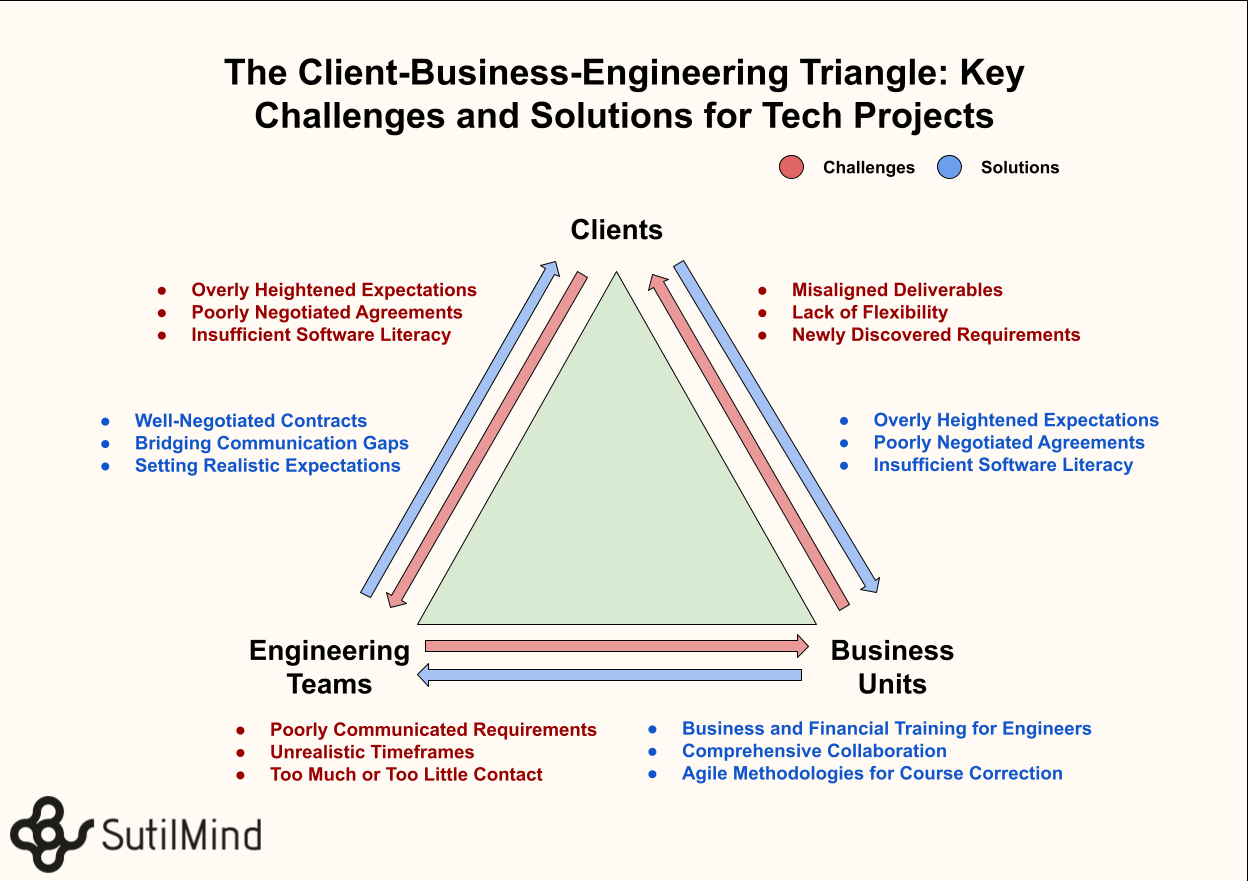In the tech industry, one of the most persistent challenges is bridging the gap between clients, engineering teams, and business units. These three groups often have conflicting priorities, yet their collaboration is critical for the success of any project. Without alignment, misunderstandings and delays are common, leading to frustrations and, in some cases, failed projects.
This article explores the reasons behind the disconnect between these groups and offers practical solutions for fostering better collaboration and communication.
Understanding Each Player
The Client’s Perspective: What They Expect and Need
Clients approach tech projects with a clear goal in mind: they want a product that meets their business needs, and they want it delivered efficiently. The technical details of how that product is developed are usually less important to them; they care much more about the outcome than the process.
However, this focus on results can lead to friction. Clients may not understand the complexities involved in building a digital product or software. They might expect quick delivery without knowing how certain changes or additions affect the project timeline. Additionally, they typically don’t want to be bogged down by frequent updates or technical jargon—they simply want to know that the project is on track and progressing as expected.
Clients’ lack of technical literacy can make it difficult for them to fully appreciate the intricacies of the development process. While they may be experts in their own business, they often rely on the engineering team and business units to translate their business goals into actionable, technical plans. This creates a potential for misunderstanding, especially when they don’t realize how their decisions impact development.
The Business Units: Mediators and Pressure Points
Business units play a crucial role in managing the relationship between the client and the engineering team. They translate the client’s needs into requirements that the engineering team can execute, negotiate project timelines, and ensure that the budget and scope are maintained. Their role is to balance the business side of things—ensuring the client is happy and the project remains financially viable—while working within the technical realities the engineers face.
This intermediary role, however, places them under a great deal of pressure. Business units often feel compelled to meet client demands quickly and ensure that deadlines are met. To do this, they may negotiate deliverables that, on the surface, seem reasonable to the client but don’t fully reflect the complexities of the technical work involved. The pressure to keep the client satisfied can result in them making promises that the engineering team struggles to fulfill.
Another challenge business units face is understanding the limitations of the technology being used. They may not always grasp the technical scope, and this can lead to friction with engineers, who feel they are being asked to do the impossible. At the same time, business teams must manage the expectations of the client, keeping them informed while preventing unrealistic demands from derailing the project.
Engineering Teams: Technical Realities and Constraints
Engineering teams are responsible for the hands-on development of the product. They are the ones who turn business requirements into working solutions, ensuring that the product is functional, scalable, and meets the client’s needs. However, their work is often constrained by technical limitations and the complexity of the tasks they are assigned.
Engineers often feel the most pressure when business units overpromise to clients or when changes to the project are introduced late in the development process. What seems like a minor tweak to the client or business team can require significant reworking of the code, delays, and additional testing. Engineers are focused on delivering high-quality, robust solutions, but they sometimes feel that their concerns about quality or feasibility are overridden by the desire to meet client deadlines.
Moreover, engineers typically work with a long-term perspective in mind. They are concerned with building a product that is stable and scalable, while clients and business units often focus on short-term wins and getting the product to market as quickly as possible. This misalignment of priorities can lead to tension, as engineers push for more time and resources, while business units and clients push for quicker results.
The Disconnect Between Teams
The friction between clients, business units, and engineering teams often stems from misaligned priorities, communication barriers, and unrealistic expectations. Let’s examine these issues in more detail.
Misalignment of Goals: Deliverables vs. Expectations
At the core of many tech project challenges is a misalignment of goals. Clients want a product delivered quickly and at a high standard, without fully understanding the technical challenges that may arise. Business units, eager to please the client, might agree to tight deadlines or additional features without consulting the engineering team, leading to unrealistic promises.
Engineers, on the other hand, are focused on ensuring that the product works well from a technical standpoint. They are often more concerned with long-term scalability and stability, while clients and business units may be focused on short-term deliverables and immediate client satisfaction.
This misalignment creates tension. Engineers feel that they are being asked to meet impossible deadlines or sacrifice the quality of their work, while business units feel pressure from the client to deliver quickly. Meanwhile, the client may not understand why their requests, which seem reasonable, are causing delays or pushing the project over budget.
Communication Barriers: Language and Knowledge Gaps
Another common issue is the communication gap between these groups. Clients and business units often speak a different "language" than engineers. Business teams and clients may not fully grasp the technical jargon or the complexity of certain tasks, while engineers may not understand the urgency or the business rationale behind certain requests.
This lack of a common language can lead to misunderstandings and frustration on both sides. For example, a client may request a seemingly simple feature, not realizing that it requires significant back-end development. When the engineers push back or explain why the change will take time, the client may feel frustrated, believing their needs are being deprioritized.
Additionally, engineers may not always communicate the technical challenges they face in a way that is clear to non-technical stakeholders. This can create the perception that engineers are slow or uncooperative when, in reality, they are trying to ensure the product is built correctly.
Visualizing the Relationship: Navigating the Client-Business-Engineering Triangle
While it’s essential to understand the unique pressures and perspectives of clients, business units, and engineering teams, visualizing these relationships can help clarify the common challenges and opportunities for improvement. To that end, we’ve developed a Client-Business-Engineering Triangle, which highlights the key friction points and solutions that arise between these three critical players in a tech project.
This diagram serves as both a map of where communication typically breaks down and a guide to bridging those gaps. On the right-to-left side, we show the issues that frequently arise between clients, business units, and engineers. These include poorly communicated requirements, misaligned deliverables, and unrealistic expectations. On the left-to-right side, we present practical solutions, such as increasing software literacy for clients, fostering better collaboration between engineers and business units, and implementing agile methodologies.

How to Use the Diagram:
- Clients can see where their expectations or lack of technical literacy might create friction and learn how clear communication of business goals can ease that tension.
- Business Units can identify how they act as intermediaries, helping to improve communication between clients and engineers by managing expectations and translating needs more effectively.
- Engineering Teams can understand how being more transparent about technical realities, using agile processes, and educating business units can improve the overall workflow and satisfaction of both internal and external stakeholders.
By understanding the dynamics illustrated in the diagram, all teams involved in a project can work together more effectively, minimizing frustrations and maximizing project success.
Bridging the Gap for Long-Term Success
Bridging the gap between clients, business units, and engineering teams is no easy task, but it is essential for the success of any tech project. Misaligned goals, communication barriers, and unrealistic expectations are common pitfalls, but by fostering empathy, improving communication, and ensuring that everyone is working towards the same objectives, you can create a more collaborative and productive environment.
Ultimately, success lies in understanding the unique pressures each group faces and finding ways to align their priorities. By doing so, not only will projects be completed more smoothly, but stronger, more resilient teams will be built—capable of tackling even the most complex challenges.
